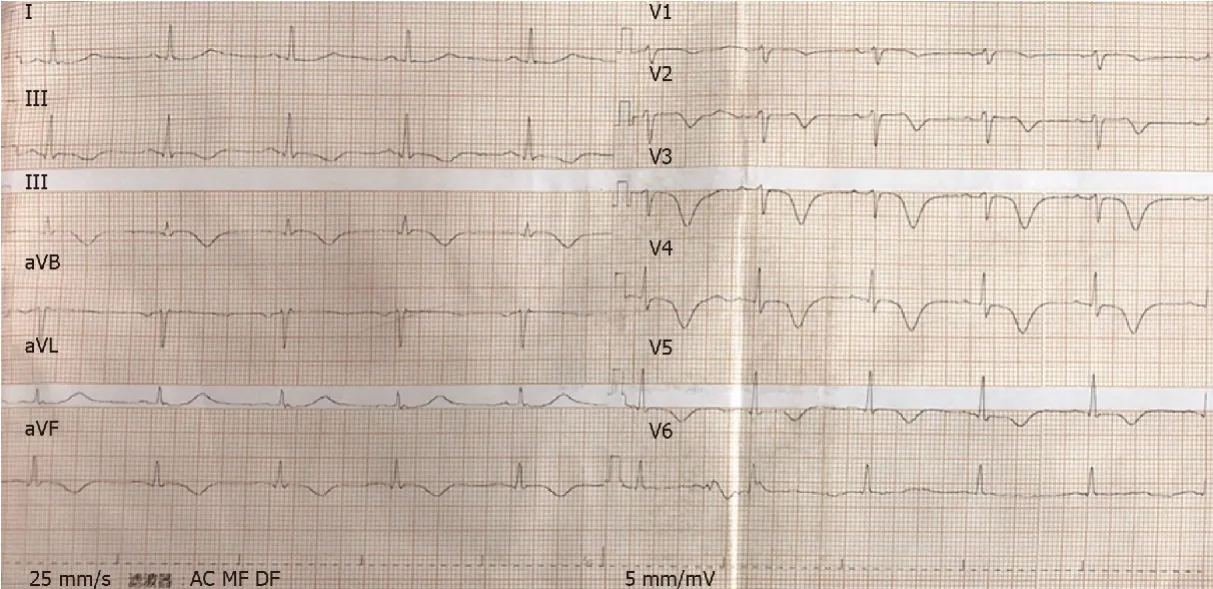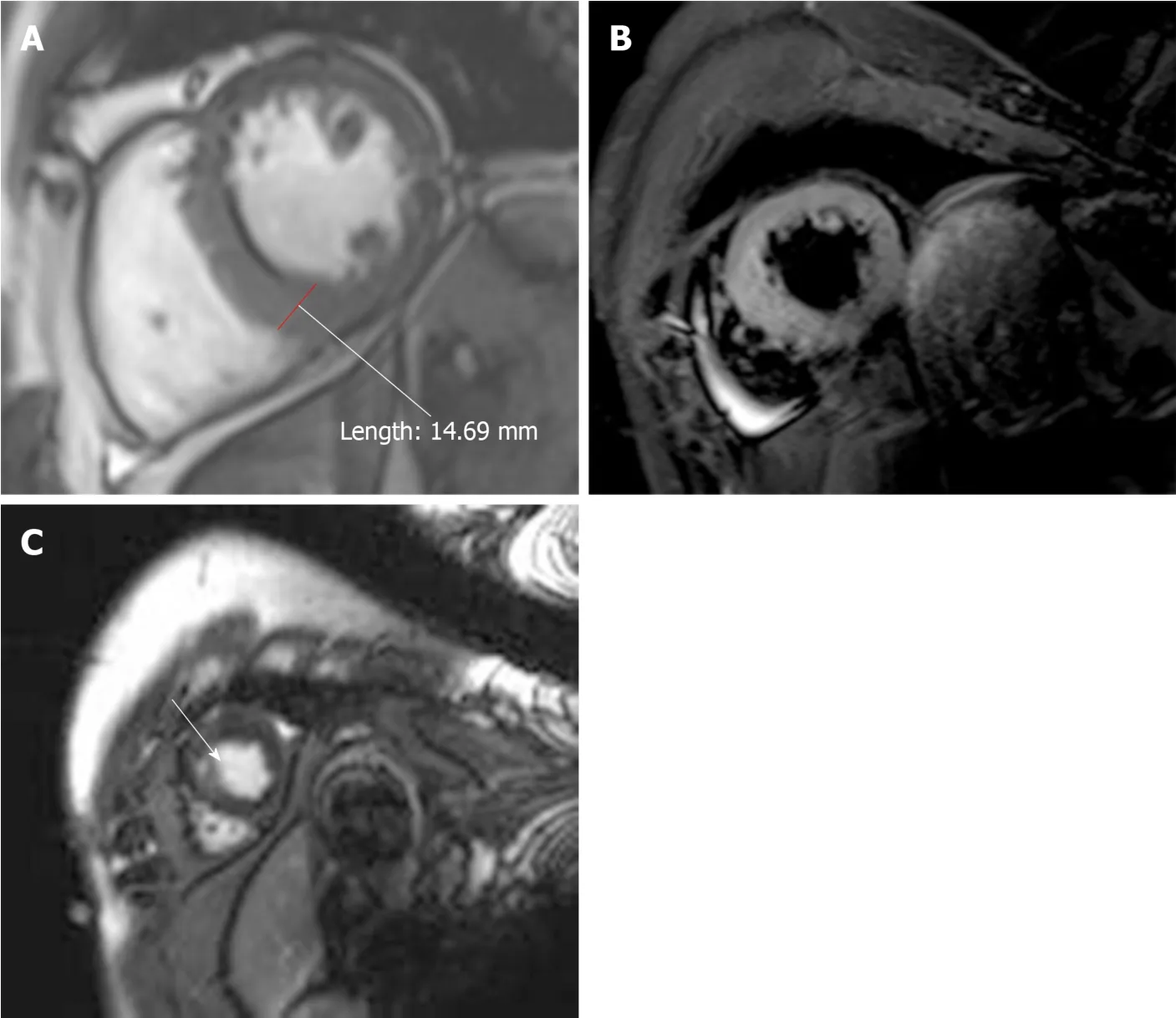Myocarditis presenting as typical acute myocardial infarction:A case report and review of the literature
2020-04-22YaMinHouPengXiHanXiaWuJingRuLinFeiZhengLinLinRuiXu
Ya-Min Hou, Peng-Xi Han, Xia Wu, Jing-Ru Lin, Fei Zheng, Lin Lin, Rui Xu
Ya-Min Hou, Xia Wu, Lin Lin, Rui Xu, Department of Cardiology, Shandong Provincial Qianfoshan Hospital, Shandong University, Jinan 250014, Shandong Province, China
Peng-Xi Han, Department of Radiology, The First Affiliated Hospital of Shandong First Medical University, Jinan 250014, Shandong Province, China
Jing-Ru Lin, Department of Cardiology, Shandong Provincial Third Hospital, Jinan 250014,Shandong Province, China
Fei Zheng, Rui Xu, Department of Cardiology, The First Affiliated Hospital of Shandong First Medical University, Jinan 250014, Shandong Province, China
Abstract
Key words: Myocarditis; Myocardial infraction; Magnetic resonance imaging;Cardiomyocytes; Follow-up study; Case report
INTRODUCTION
Myocarditis has heterogeneous manifestations with respect to pathological immune processes in the heart.A variety of factors, such as infection and immune diseases, can cause myocarditis, which may manifest as acute heart failure, ventricular arrhythmias, myocardial infarction, or even cardiogenic shock.Serum biomarkers,especially troponin I (TnI) and troponin T (TnT), can be elevated.Abnormalities in electrocardiogram (ECG) can include nonspecific ST-segment changes, T-wave inversions, and ST-segment elevations[1].The cause of myocarditis is usually a viral infection; the most cited viruses are enteroviruses, adenoviruses, parvovirus B19,human herpesvirus 6, human cytomegalovirus, Epstein-Barr virus, and hepatitis virus[2-4].Cardiovascular magnetic resonance (CMR) has become the primary tool for non-invasive assessment of myocardial inflammation in patients with suspected myocarditis[5].Here, we present a case of viral myocarditis that mimicked acute coronary syndrome and performed a literature.Compared to the cases reported in the literature, our patient's ECG showed typical dynamic changes of acute myocardial infarction.We also used CMR to closely record the long-term dynamic progression of the patient's prognosis.
CASE PRESENTATION
Chief complaints
A 42-year-old man presented with cough that had started 1 wk earlier and chest pain that had begun 2 d earlier.
History of present illness
The patient presented with cough that had started 1 wk earlier; he was treated with azithromycin (500 mg, qd, i.v.) for a common cold at a private clinic.His symptoms were alleviated after treatment.However, 2 d later, the patient experienced chest pain radiating to the right arm while walking in a cold wind.He was evaluated at another hospital, where his hypersensitive troponin T level was found to be 34.34 pg/mL(normal range:3-14 pg/mL).He also exhibited increased white blood cell and platelet counts and an increased neutrophil percentage.His ECG (Figure 1) was normal.Echocardiography showed that the left ventricular ejection fraction (LVEF) was 59%,with mild regional abnormalities in the ventricular and apical septa and a dilated left atrium.The patient's hypersensitive troponin T was 685.30 pg/mL and the creatine kinase isozyme (CK-MB) level was 11.85 ng/mL (normal range:0.1-4.94 ng/mL) after 8 h.Based on these findings, the patient was admitted to our hospital.

Figure 1 Electrocardiogram showing V2-5 T-wave towering after the chest pain.
History of past illness
The patient had a 2-year history of hypertension and a smoking history for 20 years.
Personal and family history
No specific personal or family history of disease was recorded.
Physical examination upon admission
The patient's temperature was 37.8 °C, his body mass was 78 kg, his blood pressure was 164/114 mmHg, and there were no positive signs on a physical examination.
Laboratory examinations
Laboratory testing showed the following on admission:serum TnI, 2.57 ng/mL(normal range:0-0.034 ng/mL); hypersensitive C-reactive protein, 4.95 mg/L (normal range:0-2.87 mg/L); erythrocyte sedimentation rate, 45 mm/h; brain natriuretic peptide, 168 pg/mL; white blood cell count, 13.30 × 109/L; neutrophil percentage,0.735; and platelet count, 312 × 109/L.His liver function, kidney function, thyroid function, D-dimer, electrolytes, blood lipids, and blood glucose levels showed no significant abnormalities; however, his rubella virus immunoglobulin G (IgG) and immunoglobulin M (IgM) antibody levels were elevated on admission.
Imaging examination
The patient's ECG (Figure 2) showed II, III, and aVF T-wave inversions, and a wide range of precordial segment T-wave inversions that exhibited dynamic changes compared with the previous ECG.Electrocardiography (Figure 3) revealed the abovementioned segment T-wave inversion after 20 h.Coronary angiography was performed on day 5 after admission.There was no obvious coronary stenosis during the operation.Cine CMR imaging showed wall motion abnormalities (mid septal,apical septal, and apical anterior), and the anterior walls were obviously thicker than the normal walls (Figure 4A), with the thickest part of the ventricular wall being approximately 20 mm.Fat suppressed T2-weighted imaging showed the edema of the mid septal, apical septal, and apical anterior walls (Figure 4B).We observed the myocardial edema more specifically on T1 mapping (Figure 4C).The endocardium and middle myocardium of the mid septal and apical septal walls showed patchy late gadolinium enhancement (LGE) (Figure 4D).The high signal area was smaller than the area of edema.
FINAL DIAGNOSIS
Taking into accounts the patient's disease history, symptoms, and examination findings, his suspected diagnosis was viral myocarditis.
TREATMENT
He was given aspirin (100 mg, qd, p.o.) and clopidogrel (75 mg, qd, p.o.) for 6 d before the CMR examination.After the CMR examination, the patient was treated using acyclovir (250 mg, q12h, i.v.) combined with levofloxacin (500 mg, qd, i.v.) for 11 d.The patient was treated with trimetazidine and creatine phosphate for 19 d during hospitalization.

Figure 2 Electrocardiogram showing ll, lll, and avF T-wave inversion and V2-5 T-wave inversion after admission.
OUTCOME AND FOLLOW UP
The patient had no more chest pain and his temperature returned to normal, as did his C-reactive protein and TnI (0.027) levels; his rubella virus-specific IgG and IgM antibody levels were slightly lower than before.A review of the CMR images showed that the edema observed in the mid septal, apical septal, and apical anterior walls was less extensive than before on T2WI; the thickest part of the ventricular wall was approximately 17 mm (Figure 5A and B) and the anterior and interior enhancement moved to the middle myocardium, confirming the diagnosis of myocarditis (Figure 5C).
The patient's condition improved and he was discharged.Ten months later, the patient was asymptomatic and the ECG was normal (Figure 6).Ultrasound echocardiography showed normal wall motion but patchy enhancement of the ventricular septal wall.At his 13-mo follow-up examination, the patient remained asymptomatic; CMR showed that the edema had disappeared and the thickest part of the ventricular wall was approximately 14 mm (Figure 7A and B).Given the patient's history of hypertension, we consider that the hypertrophy was due to high blood pressure.LGE was distributed in the myocardium, indicating fibrosis (Figure 7C).
DISCUSSION
Myocarditis has numerous manifestations.This report describes a case of myocarditis that masqueraded as acute coronary syndrome.Myocarditis that mimics myocardial infarction presents with elevated serum TnI, TnT, and myocardial enzyme (e.g., CKMB) levels, and electrocardiograph may reveal ST-segment elevation or depression,and/or Q- and T-wave inversions.The coronary angiogram is usually normal.In a study that showed the patients with an initial clinical presentation of acute myocardial infarction with normal coronary angiograms, almost 77% were suspected of having myocarditis according to the imaging data[6].In addition to coronary angiography, myocarditis and myocardial infarction can be identified by CMR.The“Lake Louise Criteria” recommend a combination of CMR techniques, including T1-weighted early gadolinium enhancement, LGE, and T2-weighted edema imaging[5].Gerbaudet al[7]reported that CMR is able to identify the cardiac etiology of troponin elevation in more than 75% of patients.In a large T1 and T2 mapping trial, T1 mapping provided the best diagnostic parameters in patients who had been diagnosed with acute myocarditis during 2 wk[8].A 16-mo follow-up study showed that infarction-like myocarditis usually recovers to normal cardiac function, but still has the possibility of becoming enlarged[9].Although endomyocardial biopsy (EMB) is the gold standard for diagnosing myocarditis, its invasiveness and low sensitivity limit its clinical application.The optimum management of myocarditis remains controversial.Currently, the management focuses largely on supportive care; patients receive standard heart failure treatment and are instructed to refrain from competitive athletics for up to 6 mo[10].Immunosuppression should be started only after ruling out an active infection on EMB[11].The utility of intravenous immunoglobulin in viral myocarditis remains to be investigated, but it was shown to improve the LVEF in some clinical trials of viral myocarditis[12].

Figure 3 Electrocardiogram showing ll, lll, and avF T-wave inversion and V2-5 T-wave inversion at 20 h after admission.
In the case described herein, the patient's initial symptom was chest pain;biomarkers such as TnI and CK-MB were elevated and the ECG showed ST-segment elevation and T-wave inversion.The patient's chest radiograph and D-dimer level were normal, thus excluding pulmonary embolism.There was no difference in blood pressure between the two sides of the limb, thus excluding aortic dissection.Valvular disease was excluded by echocardiography.Pericarditis was also ruled out because there was no pericardial friction or effusion.The patient's initial presentation suggested acute myocardial infarction.We recommended coronary angiography for several times within 72 h after the patient was admitted to the hospital.The patient felt that the chest pain was alleviated and there was no hemodynamic disorder, so he refused the examination.Upon our repeated recommendation, the patient agreed to undergo coronary angiography 5 d after admission.However, the normal coronary angiography contradicted this diagnosis.CMR revealed diffuse LGE in the endocardium and myocardium, but later it moved to the myocardium.A previous study demonstrated that the presence of a subendocardial or transmural pattern on LGE was strongly associated with acute myocardial infarction and that the presence of midmyocardial and epicardial or patchy LGE indicated acute myocarditis[13]; thus,we excluded the possibility of ischemic cardiomyopathy in making our diagnosis.The chest pain experienced by our patient may have started with a viral infection of endothelial cells in myocardial vessels, leading to endothelial dysfunction and coronary vasospasms; the subsequent migration of inflammatory cells into the myocardial interstitium preceded myocyte damage[14].In addition, the patient's rubella virus-specific IgG and IgM antibody levels were abnormally elevated.To sum up, we confirmed the diagnosis of myocarditis.The diagnosis of viral myocarditis was established according to the 2015 ESC myocarditis task force guidelines.Although the patient did not undergo EMB, the 2015 ESC guidelines on CMR for pericardial disease recommend confirmation of myocardial involvement (myocarditis) as a Class I recommendation[15].Regarding viral infection, without EMB, the pathogen can only be suspected as rubella virus.However, due to the combination of symptoms and signs in this patient, and the history of flu-infection, we still consider this as a case of viral myocarditis.
We also performed a literature review (Table 1)[16-25].MEDLINE was searchedviaPubMed for English articles using the terms “myocarditis” AND “chest pain or acute coronary syndrome”; the type of article searched for was “case reports” and 100 such reports were found.Articles were included if (1) the cause of myocarditis was confirmed or suspected as viral infection; (2) there were no concomitant diseases, such as pericarditis or myopercarditis; and (3) the age of the patients was greater than 12 years.The search identified 10 articles.
Except for human immunodeficiency virus, all cases presented with flu-like premonitory symptoms.Four of the ten cases did not have a specific pathogen;however, combined with other evaluations, they were also diagnosed with viral myocarditis.Dr.Chen holds the view that biopsy may be more appropriate for fulminant or giant cell myocarditis[19].
The ECG showed ST-T segment changes in most of the eight patients.Our case showed a change typical of acute coronary syndrome, and this is a major reason why we first suspected acute coronary syndrome.

Figure 4 Cardiovascular magnetic resonance imaging.
Six of the ten patients underwent CMR.All subjects showed wall motion abnormalities; five showed LGE.A feature of our case is that we performed the coronary angiography and observed a complete process from severe edema of the ventricular wall to significant reduction in short-term review and dissipation after 13 mo.The area of LGE was significantly smaller than that on T2WI the first time, and the ECG showed ischemia on the inferior wall and over a wide area of the anterior wall.We believe that the main cause of ischemia was not necrosis, but edema.Edema of the myocardium causes microcirculatory disturbances, leading to myocardial ischemia at the corresponding site.After 12 d, a review of the CMR revealed that the edema had subsided compared with the previous scan; the thickest part was reduced from 20 to 17 mm and the enhancement moved to the middle myocardium.Anti-heart failure and antiviral drugs were used for treatment.Although the optimal treatment for myocarditis remains unclear, our patient's edema decreased within 12 d after treatment, proving that the application of anti-heart failure and antiviral drugs is effective.No abnormal heart function was detected at the 13-mo follow-up examination.Thirteen months later, CMR showed that the patient's edema had disappeared; the thickest wall was only approximately 14 mm.The apical septal LGE suggested fibrosis in the myocardium.A previous study showed that CMR is more likely to detect myocardial damage if the scan is performed within 2 wk after the onset of myocardial infarction[26].The levels of cardiac and inflammatory markers were also decreased compared to normal; thus, dynamic observation by CMR is essential.A previous study demonstrated that cardiac enzymes and inflammatory parameters do not sufficiently reflect LGE in myocarditis[27].Therefore, in patients presenting with acute coronary symptoms, abnormal ECG, and raised troponin levels,early myocardial magnetic resonance imaging is essential.
CONCLUSION
In this case, we conclude that myocarditis may have mimicked myocardial infarction.For a middle-aged man with myocardial infarction, the possibility of acute myocardial infarction should be ruled out first.It is also important to consider myocarditis, such that early CMR has a strategic role in the differential diagnosis.Traditional heart failure medications and antiviral treatments are effective for myocarditis.

Table 1 Characteristics of participants in the included studies

F:Female; M:Male; UCG:Ultrasound echocardiography; CAG:Coronary angiography; LGE:Late gadolinium enhancement; LVEF:Left ventricular ejection fraction; ECG:Electrocardiogram; CMR:Cardiovascular magnetic resonance.

Figure 5 Cardiovascular magnetic resonance imaging.

Figure 7 Cardiovascular magnetic resonance imaging.
杂志排行
World Journal of Clinical Cases的其它文章
- Awareness during emergence from anesthesia:Features and future research directions
- Risk factors for adverse cardiac events in adults with fulminant myocarditis during hospitalization
- Malignant tumors associated with Peutz-Jeghers syndrome:Five cases from a single surgical unit
- Pathogens causing diarrhoea among Bangladeshi children with malignancy:Results from two pilot studies
- One-year rotational relapse frequency following conventional circumferential supracrestal fiberotomy
- LINX® reflux management system to bridge the “treatment gap” in gastroesophageal reflux disease:A systematic review of 35 studies
